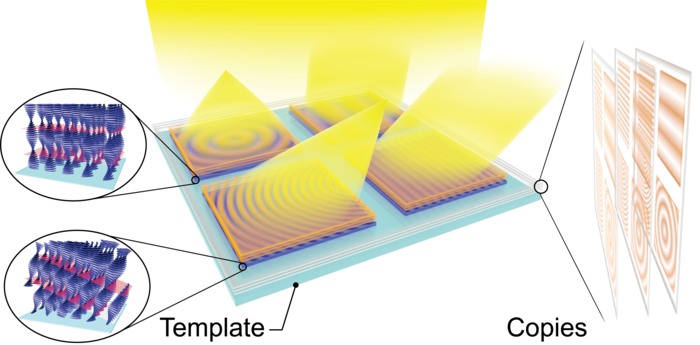Planar liquid crystal (LC) optics has recently gained popularity as a new holographic optical element (HOE). Planar LC optics demonstrates unique properties such as polarization selectivity, dynamic modulation and broad angular and spectral bandwidths, in addition to the capacity to record and recreate arbitrary wavefronts as in classic HOEs.

Image Credit: Jianghao Xiong, Qian Yang, Yannanqi Li, and Shin-Tson Wu.
These benefits, combined with its ultrathin profile and excellent efficiency, make planar LC optics a compelling choice for next-generation head-mounted screens, such as augmented reality (AR) and virtual reality (VR), which seek high picture quality, lightweight and compact form factors.
However, for this technology to be widely used, the question of mass production must be seriously studied. For the holographic exposure, the most common process of production for planar LC optical elements has so far relied on lab-scale interferometers.
Although this process works well for generating centimeter-sized samples, it becomes a bottleneck for large-scale, increased industrial manufacturing. Another diffractive optical device that is frequently used in waveguide projections, the surface relief grating (SRG), benefits from nanoimprinting for mass manufacture.
Nanoimprinting typically uses high-precision lithography technology, such as electron beam lithography, to create a master plate, which is subsequently replicated. Although there are certain drawbacks to this approach, such as the master plate’s short lifetime and replication accuracy, its main advantage of high performance has led to early success in SRG-waveguide displays.
A group of researchers led by Professor Shin-Tson Wu of the University of Central Florida’s College of Optics and Photonics developed an exciting concept termed “holo-imprinting” to realize the optical duplication of planar LC optics.
Due to its non-contact property, this approach not only illustrates the viability of mass manufacturing but also eliminates the concerns about master lifetime and imprinting quality. The study was published in the journal Light: Science & Applications.
Traditional HOEs use light intensity modulation to create patterned fringes, which causes molecular diffusion. Planar LC optics, on the other hand, uses a pattern recording process known as photoalignment, which is commonly employed in commercial LCD devices such as smartphones and televisions. Instead, photoalignment molecules are particularly sensitive to light polarization, with linear polarization producing the best alignment quality.
The holographic exposure technique requires the production of a high-quality linear polarization field. To produce the linear polarization field pattern, conventional interferometric methods used two circularly polarized beams with opposite handedness (left and right).
However, Wu’s team found in their study that two circularly polarized beams of the same handedness could also produce significant linear polarization fields, but they had to be incident on the recording sample from opposing directions.
The recently created reflective planar LC optics, by chance, completely meets this criterion. This type of reflective LC optics is made of cholesteric liquid crystal, which self-assembles and produces stable helical structures. Only the circularly polarized beam with the same handedness as the helix is reflected. The polarization condition of reflected light is identical to that of incident light.
Wu’s team empirically tested the notion and manufactured samples, including gratings and lenses that demonstrate high optical quality, based on this method. The sample size for proof-of-concept is around 5 cm. However, the researchers pointed out that by adding techniques like laser scanning or multi-area exposure, they can easily scale up the template size.
Journal Reference:
Xiong, J., et al. (2022) Holo-imprinting polarization optics with a reflective liquid crystal hologram template. Light: Science & Applications. doi.org/10.1038/s41377-022-00746-3.